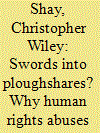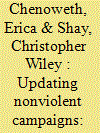|
|
|
Sort Order |
|
|
|
Items / Page
|
|
|
|
|
|
|
| Srl | Item |
| 1 |
ID:
190025


|
|
|
|
|
| Summary/Abstract |
Human rights abuse tends to increase during national crises, such as civil wars and mass nonviolent uprisings. Under what conditions does this abuse abate or persist? I argue that violent challenges provoke much more coercive state responses, exposing more personnel within the security forces to extreme forms of repression and priming them (both leaders and followers) to reproduce these behaviors after the conflict has terminated. This effect is mitigated or avoided when challengers rely on nonviolent tactics instead of violence, leading to less post-conflict abuse. I test this argument with several quantitative methods, which establish a positive association between nonviolent resistance campaigns and subsequent freedom from political killings. Results also suggest that democratization can partially – but not fully – counteract the repressive legacies of violent conflict. By choosing to specialize in nonviolent tactics, therefore, resistance leaders avoid a repression trap that not even democratization can fully disarm.
|
|
|
|
|
|
|
|
|
|
|
|
|
|
|
|
| 2 |
ID:
189002


|
|
|
|
|
| Summary/Abstract |
In this article, we introduce an updated version of the Nonviolent and Violent Campaigns and Outcomes dataset (NAVCO 2.1), which compiles annual data on 389 nonviolent and violent mass movements for regime change, anti-occupation, and secession from 1945 to 2013. This version of the dataset corrects known coding errors in NAVCO 2.0, adds news cases (including the Arab uprisings), and codes attributes for each campaign year (such as participation size and diversity, the behavior of regime elites, repression and its effects, support from external actors, and campaign outcomes). In addition, NAVCO 2.1 adds several new attributes to each campaign-year, including more precise participation figures, more nuanced data about the scope, intensity, and degree of violent flank behavior and state repression, and further information about the parallel or alternative institutions developed by the campaign. The data reveal four key findings: (1) that the success rate of nonviolent resistance campaigns has declined since 2001; (2) that far more people have participated in nonviolent than violent campaigns in the postwar period; (3) that nonviolent campaigns suffer far fewer per-capita fatalities than armed campaigns; and (4) that incidental violence by dissidents has become a more common feature of contemporary nonviolent campaigns compared with earlier cases. The article concludes with suggestions for further research.
|
|
|
|
|
|
|
|
|
|
|
|
|
|
|
|
|
|
|
|
|